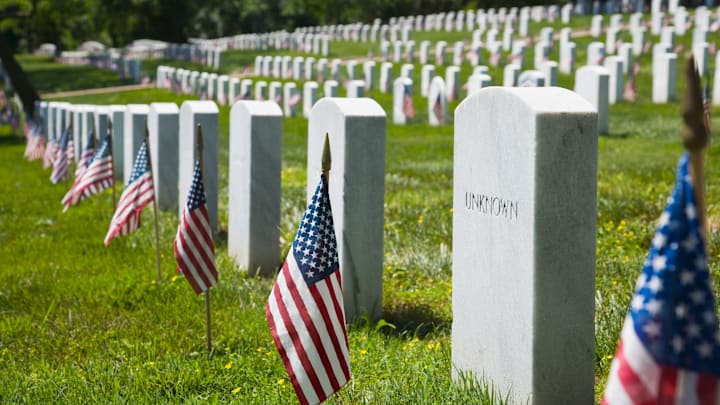Arlington National Cemetery is some of the most hallowed ground in the United States. More than 420,000 fallen servicemen and women are buried there and are honored with a service every Memorial Day. But despite its great importance, the cemetery has had more than its share of scandals.
Illegal Beginnings
Arlington isn’t actually located in Washington, D.C., but just outside it, in Virginia. That’s because the land was seized from Robert E. Lee’s plantation in 1864. There were other options for the location of a national cemetery, but the government specifically wanted to bury Union soldiers on Lee’s land as an insult to the Confederate general. Brigadier General Montgomery C. Meigs wanted to make sure the place was uninhabitable if the Lees ever tried to return. He ordered the graves placed as close to the mansion as possible.

After the war, the Lees owed about $1400 in today’s money in taxes on the estate. Mary Lee sent someone to pay the tax, but the government refused to accept it. Instead they took half the land in a public auction and ordered the establishment of a national cemetery.
Robert E. Lee died in 1870. Four years later his grandson and heir, Custis Lee, sued the government, claiming the land had been illegally obtained. The lawsuit reached the Supreme Court, and the outcome was 5-4 in Lee’s favor. The estate, dead bodies and all, was returned to the Lee family. But Lee’s actions were more about the principle of the thing; Meigs had done a good job, and the house and grounds were now unlivable. Lee sold it back to the government for $150,000—more than $3 million today.
The Known Unknown Soldier
Controversy at Arlington continued in the 20th century. On Memorial Day in 1921, U.S. Army Sergeant Edward F. Younger was presented with the remains of four unidentified soldiers who had died in France during World War I. He selected the remains second from the right to be honored in the first Tomb of the Unknown Soldier on American soil. Further unknown soldiers were buried at the site after World War II and the Korean War.
By the time the Vietnam War came around, better systems were in place to correctly identify remains. There is evidence that the Air Force actually knew in 1978 that it had the remains of Air Force First Lieutenant Michael J. Blassie. It certainly examined the evidence with the thought that it belonged to Blassie, but, under pressure from Vietnam veterans groups to inter an unknown soldier from that war as well, the Air Force changed the designation on the remains to unknown. On Memorial Day in 1984, the remains were placed in the tomb at Arlington.

In 1994, POW/MIA activist Ted Sampley determined that based on available evidence, the remains were almost certainly Blassie’s. He wrote a paper on the subject and the family asked the government to disinter the remains for genetic testing that wasn’t available the decade before. The government refused. Four years later, when Sampley’s report was picked up by the national news, the government relented. Blassie was subsequently identified and reburied in Jefferson Barracks National Cemetery in St. Louis, Missouri. Lacking another suitable unknown, no other soldier from the Vietnam War has replaced him.
Large memorials like the Tomb of the Unknown Soldier continue to be controversial at Arlington. Because of the honor of being buried there, and because room is quickly running out, some people believe that no further memorials should be built because they take up what little space remains for burying servicemen and women. Others feel that monuments are important to represent the fallen that are not or cannot be buried in the national cemetery.
21st Century Trouble
In 2010, Arlington was back in the news for mismanagement. After a year-long investigation, Salon found that over 200 graves had been mismarked, and in some cases more than one body was buried in one grave. Those in charge refused to cooperate with the investigation, even after some family members complained that new headstones had appeared at the site where their relatives had been buried.
Record-keeping was haphazard, with up to half of all files from recent years lost or misplaced, and millions of dollars had been misappropriated, with some outside contractors being paid twice for one job.
When bodies were exhumed to make sure the right soldier was in the right grave, it became clear that many had been grossly and disrespectfully mishandled. One man discovered this when he was forced to dig through his son’s coffin himself in order to find an arm bearing an identifiable tattoo. At least four burial urns had been emptied into a landfill. While Arlington officials claimed that clerical errors resulted in bodies being buried on top of other bodies, the original discarded headstones were later found in a nearby stream.
Read More About Cemeteries:
A version of this story originally ran in 2012; it has been updated for 2025.
